tow TOYOTA SEQUOIA 2011 2.G Owners Manual
[x] Cancel search | Manufacturer: TOYOTA, Model Year: 2011, Model line: SEQUOIA, Model: TOYOTA SEQUOIA 2011 2.GPages: 688, PDF Size: 14.76 MB
Page 1 of 688
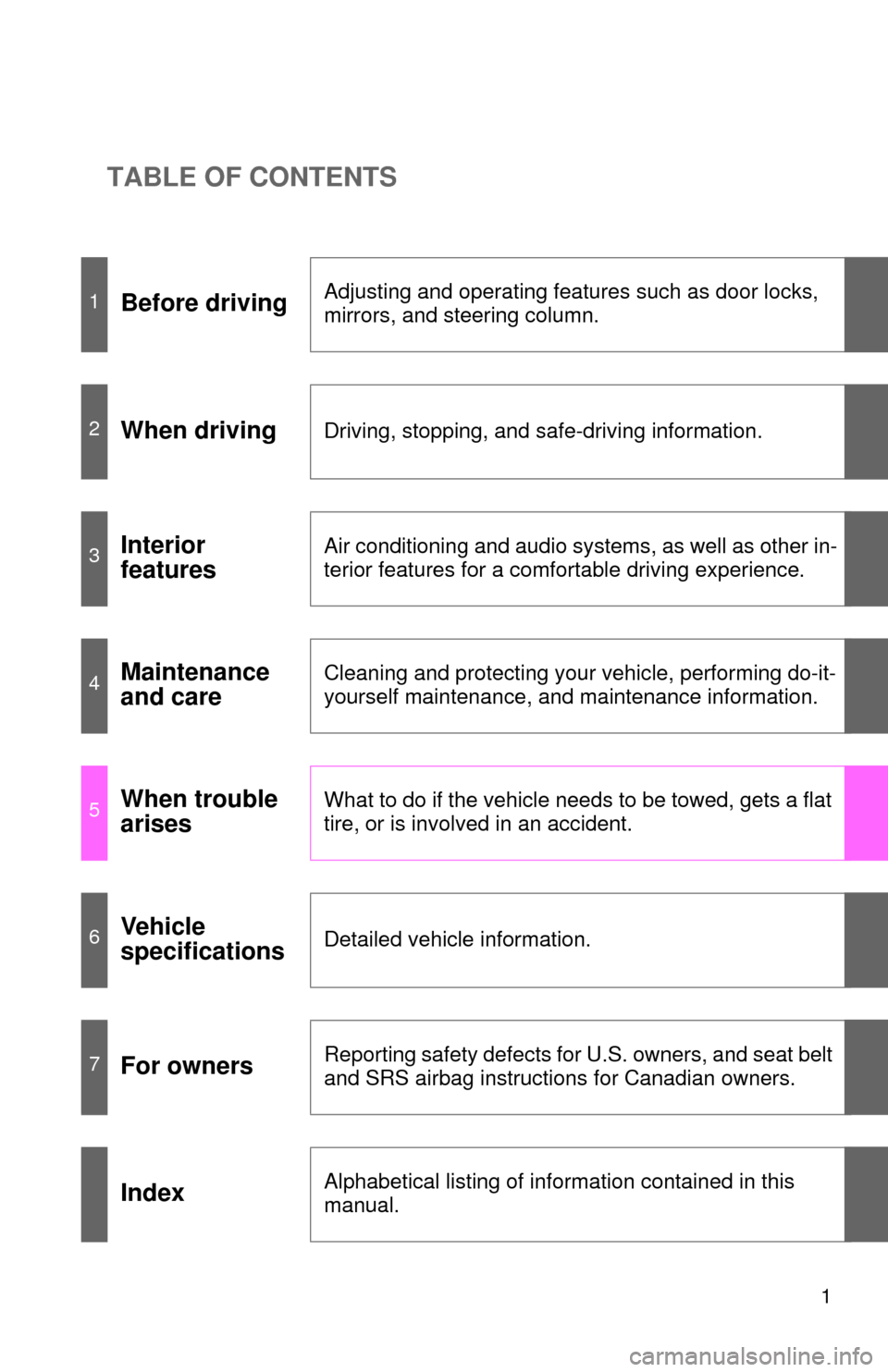
TABLE OF CONTENTS
1
1Before drivingAdjusting and operating features such as door locks,
mirrors, and steering column.
2When drivingDriving, stopping, and safe-driving information.
3Interior
featuresAir conditioning and audio systems, as well as other in-
terior features for a comfortable driving experience.
4Maintenance
and careCleaning and protecting your vehicle, performing do-it-
yourself maintenance, and maintenance information.
5When trouble
arisesWhat to do if the vehicle needs to be towed, gets a flat
tire, or is involved in an accident.
6Vehicle
specificationsDetailed vehicle information.
7For ownersReporting safety defects for U.S. owners, and seat belt
and SRS airbag instructions for Canadian owners.
IndexAlphabetical listing of information contained in this
manual.
Page 3 of 688

1
2
3
4
5
6
7
3
2-3. Operating the lights and wipers
Headlight switch .................. 186
Fog light switch ................... 190
Windshield wipers and washer .............................. 191
Rear window wiper and washer .............................. 193
Headlight cleaner switch ..... 194
2-4. Using other driving systems Cruise control ...................... 195
Dynamic laser cruise control ............................... 198
Intuitive parking assist......... 209
Rear view monitor system... 216
Electronically modulated air suspension................... 223
AVS (Adaptive Variable Suspension System) ......... 228
Four-wheel drive system ..... 229
AUTO LSD system.............. 234
Driving assist systems ........ 236
2-5. Driving information Off-road precautions ........... 242
Cargo and luggage ............. 247
Vehicle load limits ............... 251
Winter driving tips ............... 253
Trailer towing ...................... 257
Dinghy towing ..................... 277 3-1. Using the air conditioning
system and defogger
Front air conditioning system .............................. 280
Rear air conditioning system .............................. 288
Rear window and outside rear view mirror
defoggers ......................... 292
Windshield wiper de-icer .... 294
Using the steering wheel climate remote control
switches ........................... 295
3-2. Using the audio system Audio system ...................... 297
Using the radio ................... 301
Using the CD player ........... 309
Playing MP3 and WMA discs ....................... 318
Operating an iPod .............. 326
Operating a USB memory .. 332
Optimal use of the audio system .............................. 339
Using the AUX port............. 343
Using the steering wheel audio switches.................. 345
3Interior features
Page 5 of 688

1
2
3
4
5
6
7
5
Luggage compartment features ............................. 480
Garage door opener............ 485
Compass ............................. 491
4-1. Maintenance and care Cleaning and protecting the vehicle exterior............ 498
Cleaning and protecting the vehicle interior............. 500
4-2. Maintenance Maintenance requirements ..................... 503
General maintenance.......... 505
Emission inspection and maintenance (I/M)
programs........................... 508
4-3. Do-it-yourself maintenance Do-it-yourself service precautions ....................... 509
Hood ................................... 513
Engine compartment ........... 514
Tires .................................... 529
Tire inflation pressure ......... 536
Wheels ................................ 540
Air conditioning filter............ 542
Wireless remote control battery ............................... 545
Checking and replacing fuses ................................. 547
Light bulbs........................... 558 5-1. Essential information
Emergency flashers............ 572
If your vehicle needs to be towed....................... 573
If you think something is wrong ............................... 579
Fuel pump shut off system .............................. 580
Event data recorder ............ 581
5-2. Steps to take in an emergency If a warning light turns on or a warning buzzer
sounds.............................. 583
If a warning message is displayed (vehicles with
multi-information
display) ............................. 592
If you have a flat tire ........... 597
If the engine will not start.... 608
If the shift lever cannot be shifted from P ................... 610
If you lose your keys........... 611
If the vehicle battery is discharged........................ 612
If your vehicle overheats .... 615
If the vehicle becomes stuck ................................. 618
If your vehicle has to be stopped in
an emergency .................. 619
4Maintenance and care
5When trouble arises
Page 20 of 688
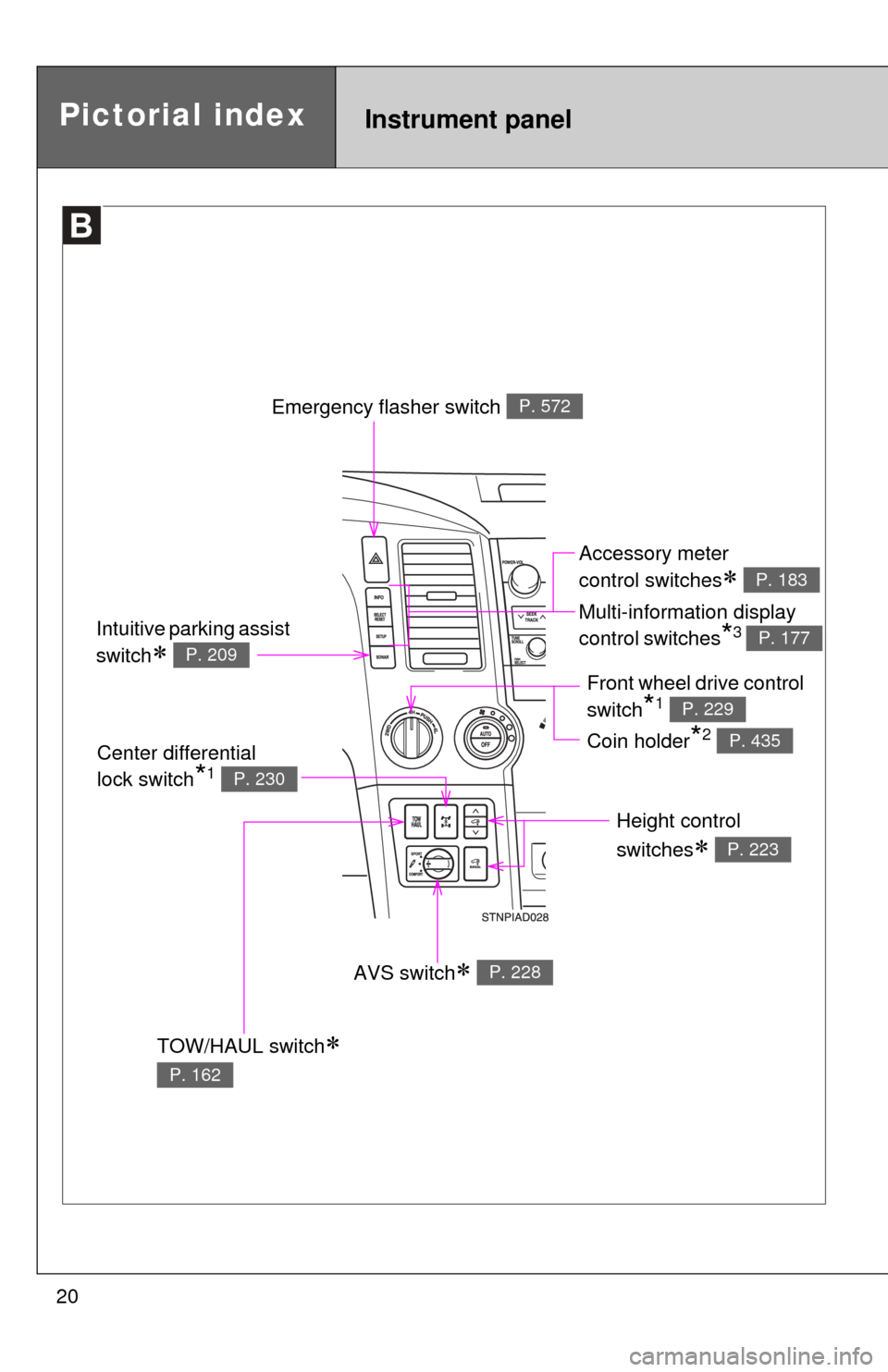
20
Pictorial indexInstrument panel
Emergency flasher switch P. 572
TOW/HAUL switch
P. 162
Height control
switches
P. 223
AVS switch P. 228
Center differential
lock switch
*1 P. 230
Accessory meter
control switches
Multi-information display
control switches
*3
P. 183
P. 177Intuitive parking assist
switch
P. 209
Front wheel drive control
switch
*1
Coin holder
*2
P. 229
P. 435
Page 35 of 688
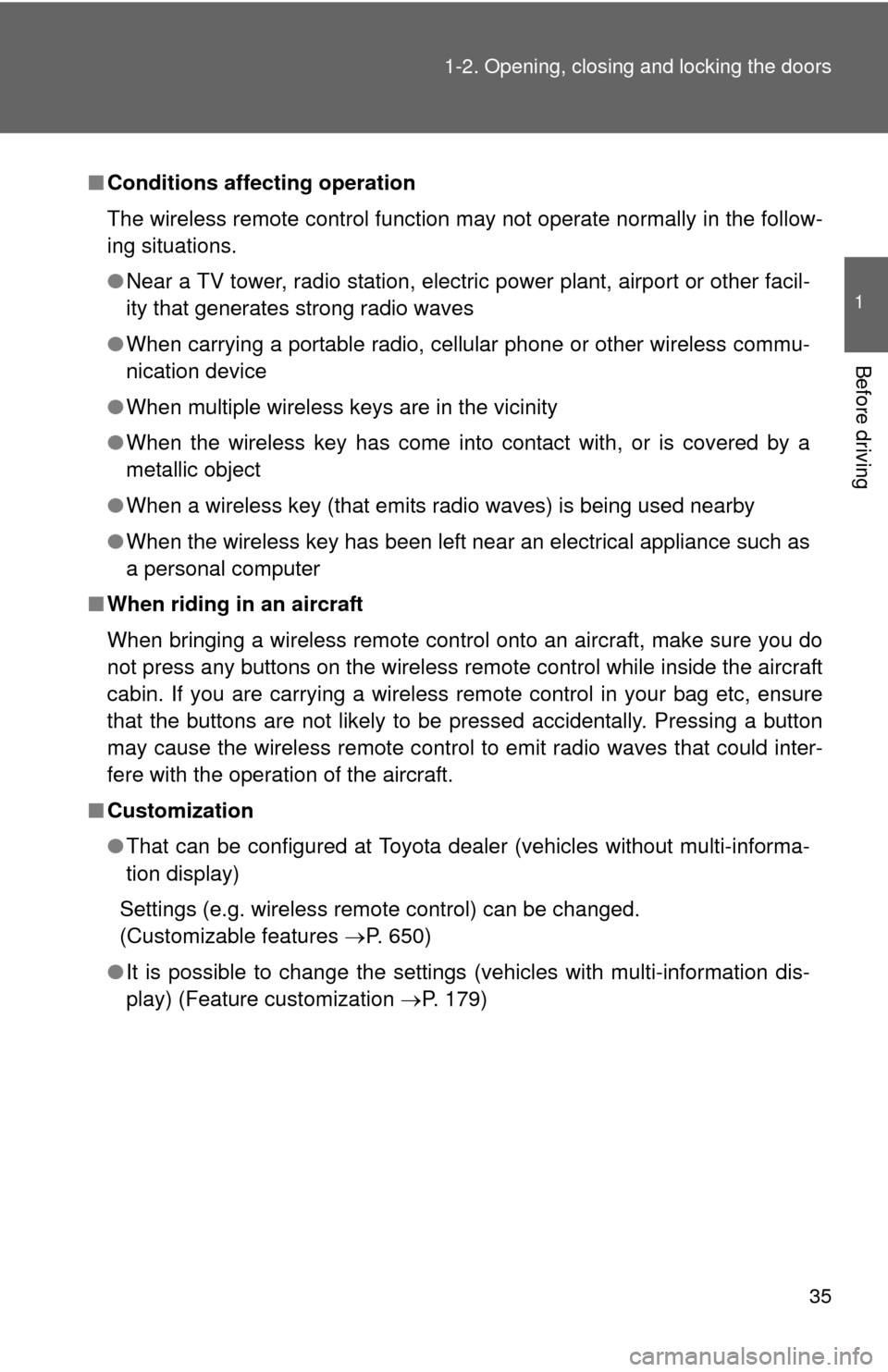
35
1-2. Opening, closing and locking the doors
1
Before driving
■
Conditions affecting operation
The wireless remote control function may not operate normally in the follow-
ing situations.
●Near a TV tower, radio station, electr ic power plant, airport or other facil-
ity that generates strong radio waves
● When carrying a portable radio, cell ular phone or other wireless commu-
nication device
● When multiple wireless keys are in the vicinity
● When the wireless key has come into contact with, or is covered by a
metallic object
● When a wireless key (that emits radio waves) is being used nearby
● When the wireless key has been left near an electrical appliance such as
a personal computer
■ When riding in an aircraft
When bringing a wireless remote control onto an aircraft, make sure you do
not press any buttons on the wireless remote control while inside the aircraft
cabin. If you are carrying a wireless remote control in your bag etc, ensure
that the buttons are not likely to be pressed accidentally. Pressing a button
may cause the wireless remote control to emit radio waves that could inter-
fere with the operation of the aircraft.
■ Customization
●That can be configured at Toyota dealer (vehicles without multi-informa-
tion display)
Settings (e.g. wireless remote control) can be changed.
(Customizable features P. 650)
● It is possible to change the settings (vehicles with multi-information dis-
play) (Feature customization P. 179)
Page 58 of 688
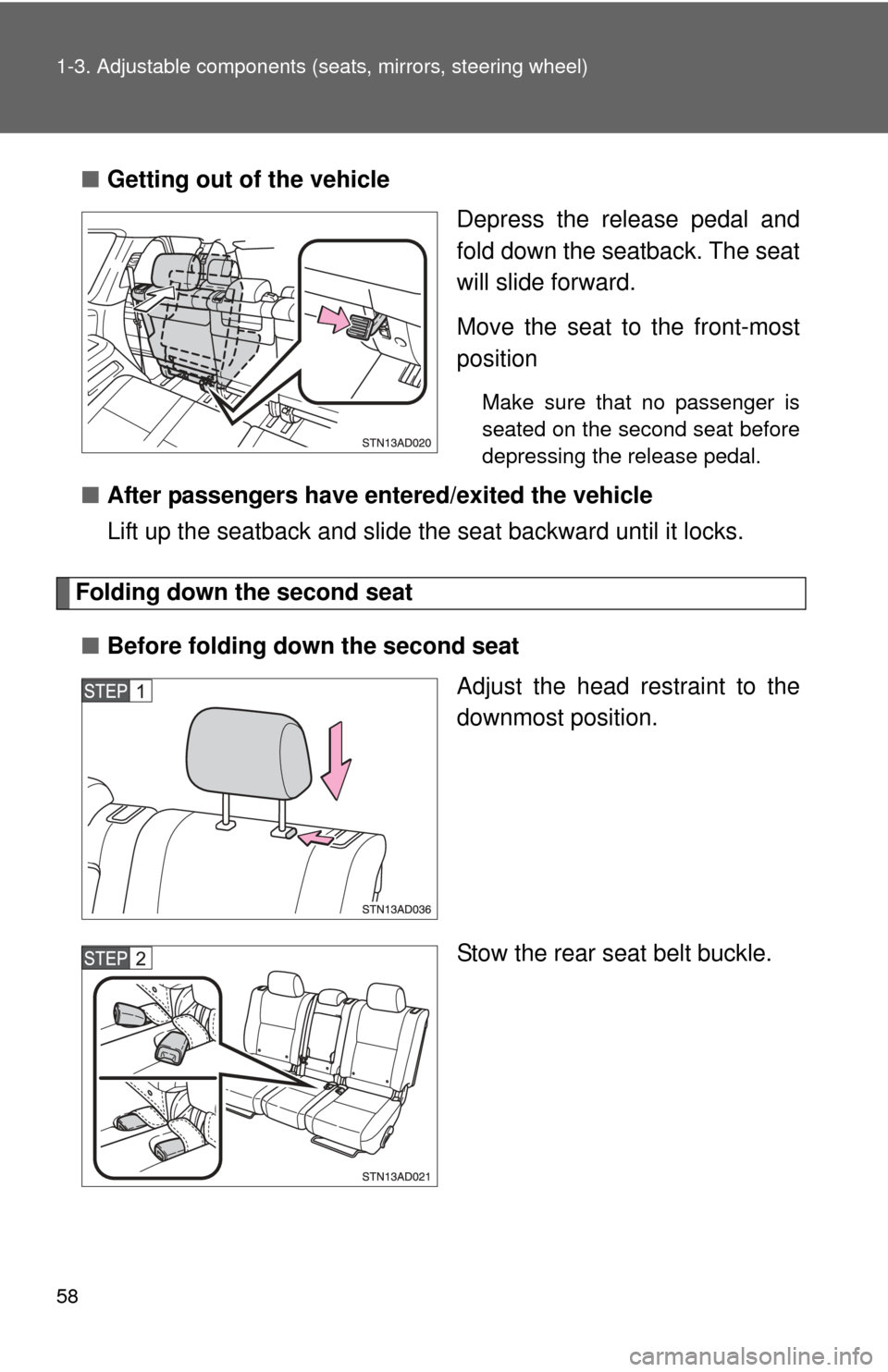
58 1-3. Adjustable components (seats, mirrors, steering wheel)
■Getting out of the vehicle
Depress the release pedal and
fold down the seatback. The seat
will slide forward.
Move the seat to the front-most
position
Make sure that no passenger is
seated on the second seat before
depressing the release pedal.
■After passengers have entered/exited the vehicle
Lift up the seatback and slide the seat backward until it locks.
Folding down the second seat
■ Before folding down the second seat
Adjust the head restraint to the
downmost position.
Stow the rear seat belt buckle.
Page 60 of 688
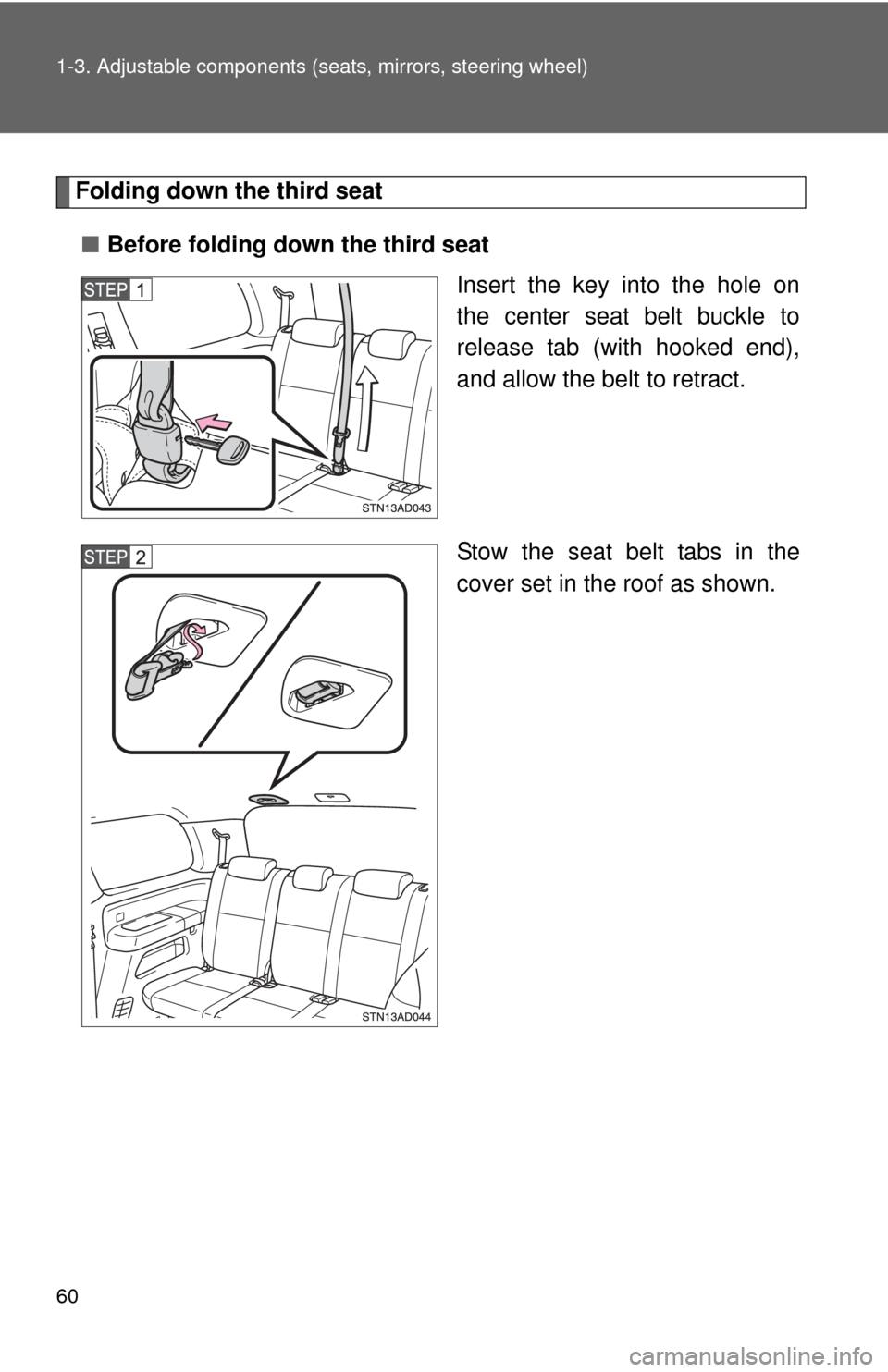
60 1-3. Adjustable components (seats, mirrors, steering wheel)
Folding down the third seat
■ Before folding down the third seat
Insert the key into the hole on
the center seat belt buckle to
release tab (with hooked end),
and allow the belt to retract.
Stow the seat belt tabs in the
cover set in the roof as shown.
Page 61 of 688
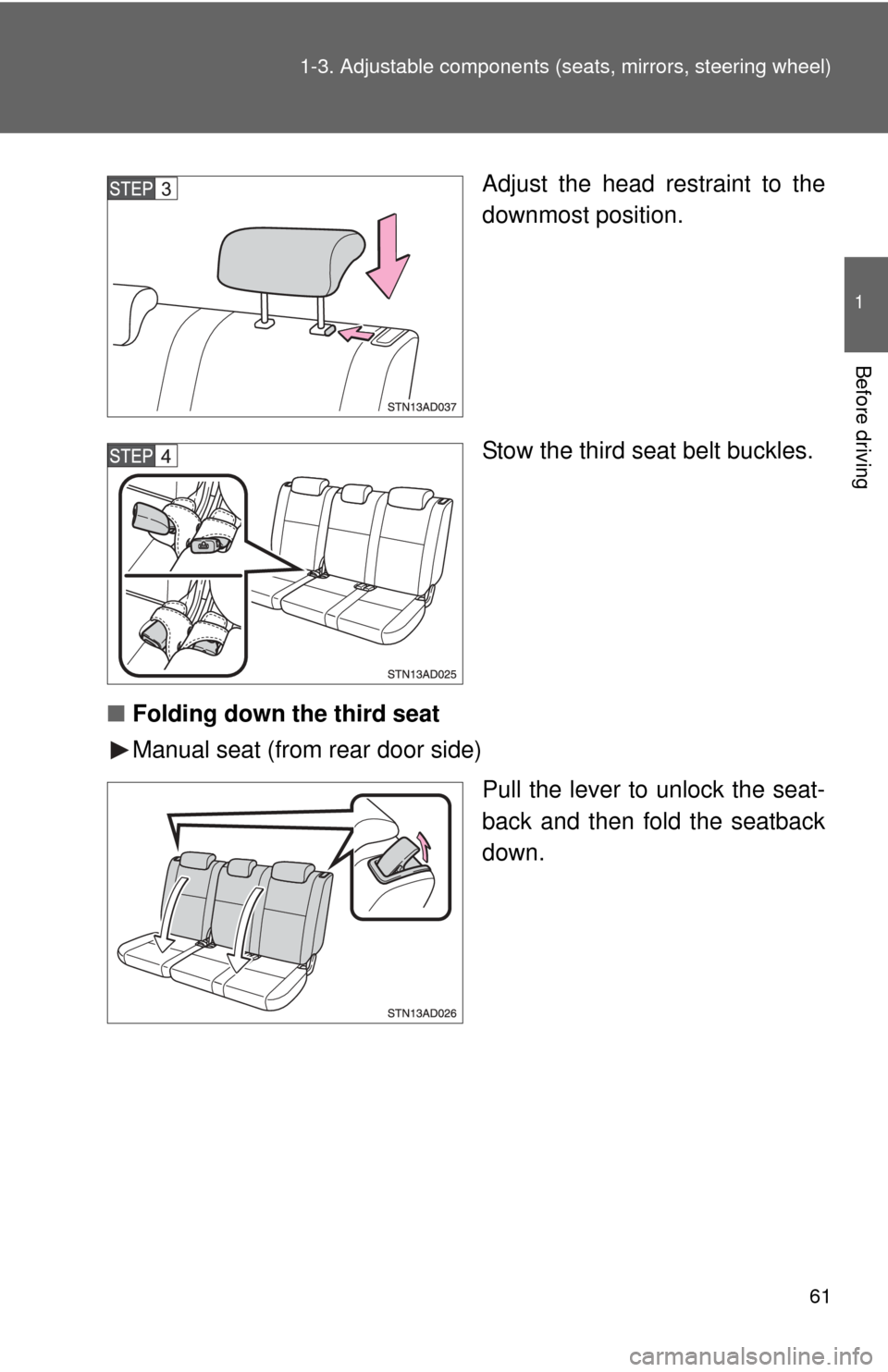
61
1-3. Adjustable components (s
eats, mirrors, steering wheel)
1
Before driving
Adjust the head restraint to the
downmost position.
Stow the third seat belt buckles.
■ Folding down the third seat
Manual seat (from rear door side)
Pull the lever to unlock the seat-
back and then fold the seatback
down.
Page 63 of 688
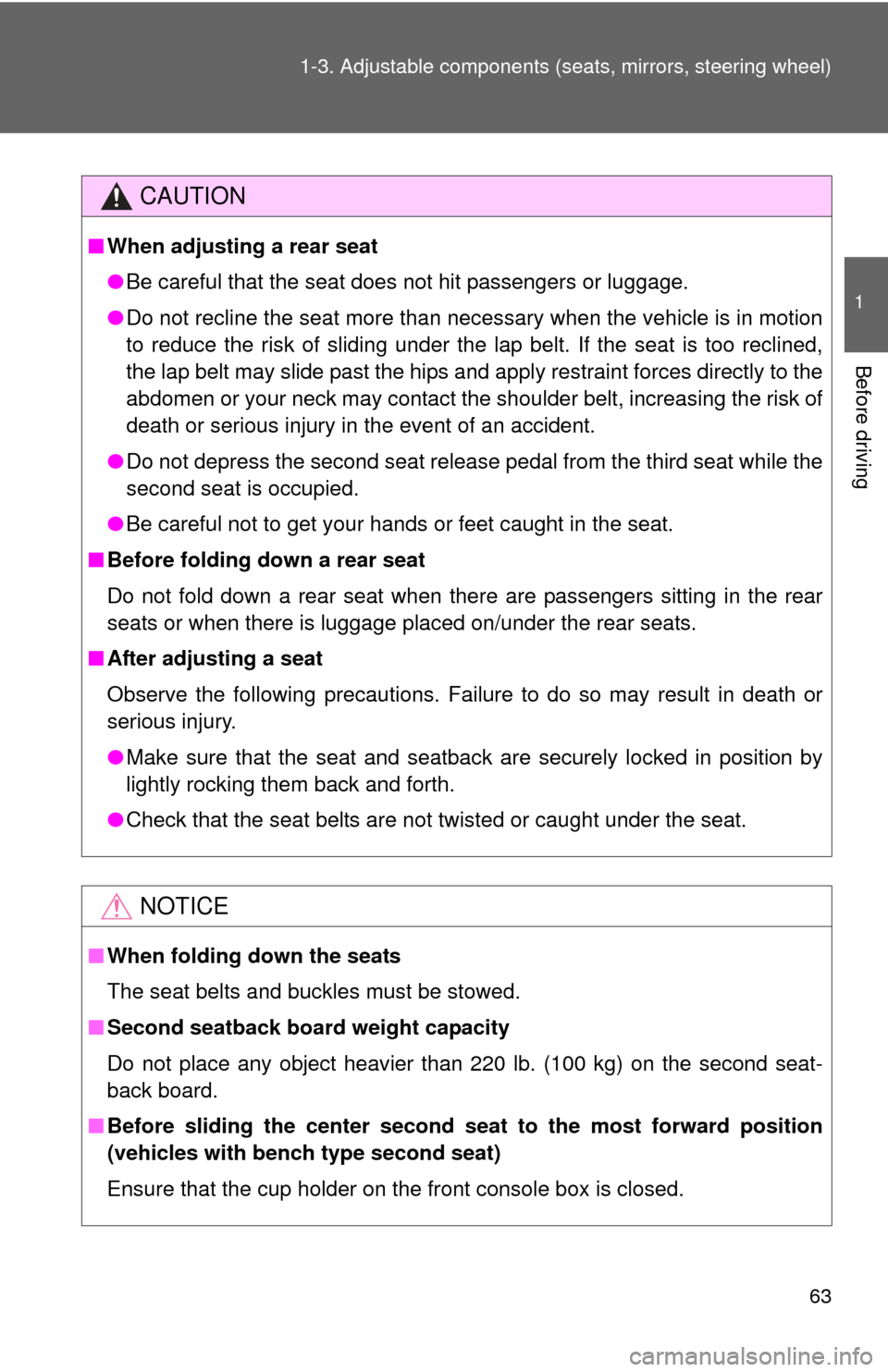
63
1-3. Adjustable components (s
eats, mirrors, steering wheel)
1
Before driving
CAUTION
■When adjusting a rear seat
●Be careful that the seat does not hit passengers or luggage.
● Do not recline the seat more than necessary when the vehicle is in motion
to reduce the risk of sliding under the lap belt. If the seat is too reclined,
the lap belt may slide past the hips and apply restraint forces directly to the
abdomen or your neck may contact the shoulder belt, increasing the risk of
death or serious injury in the event of an accident.
● Do not depress the second seat release pedal from the third seat while t\
he
second seat is occupied.
● Be careful not to get your hands or feet caught in the seat.
■ Before folding down a rear seat
Do not fold down a rear seat when there are passengers sitting in the rear
seats or when there is luggage placed on/under the rear seats.
■ After adjusting a seat
Observe the following precautions. Failure to do so may result in death or
serious injury.
●Make sure that the seat and seatback are securely locked in position by
lightly rocking them back and forth.
● Check that the seat belts are not twisted or caught under the seat.
NOTICE
■When folding down the seats
The seat belts and buckles must be stowed.
■ Second seatback board weight capacity
Do not place any object heavier than 220 lb. (100 kg) on the second seat-
back board.
■ Before sliding the center second seat to the most forward position
(vehicles with bench type second seat)
Ensure that the cup holder on the front console box is closed.
Page 74 of 688
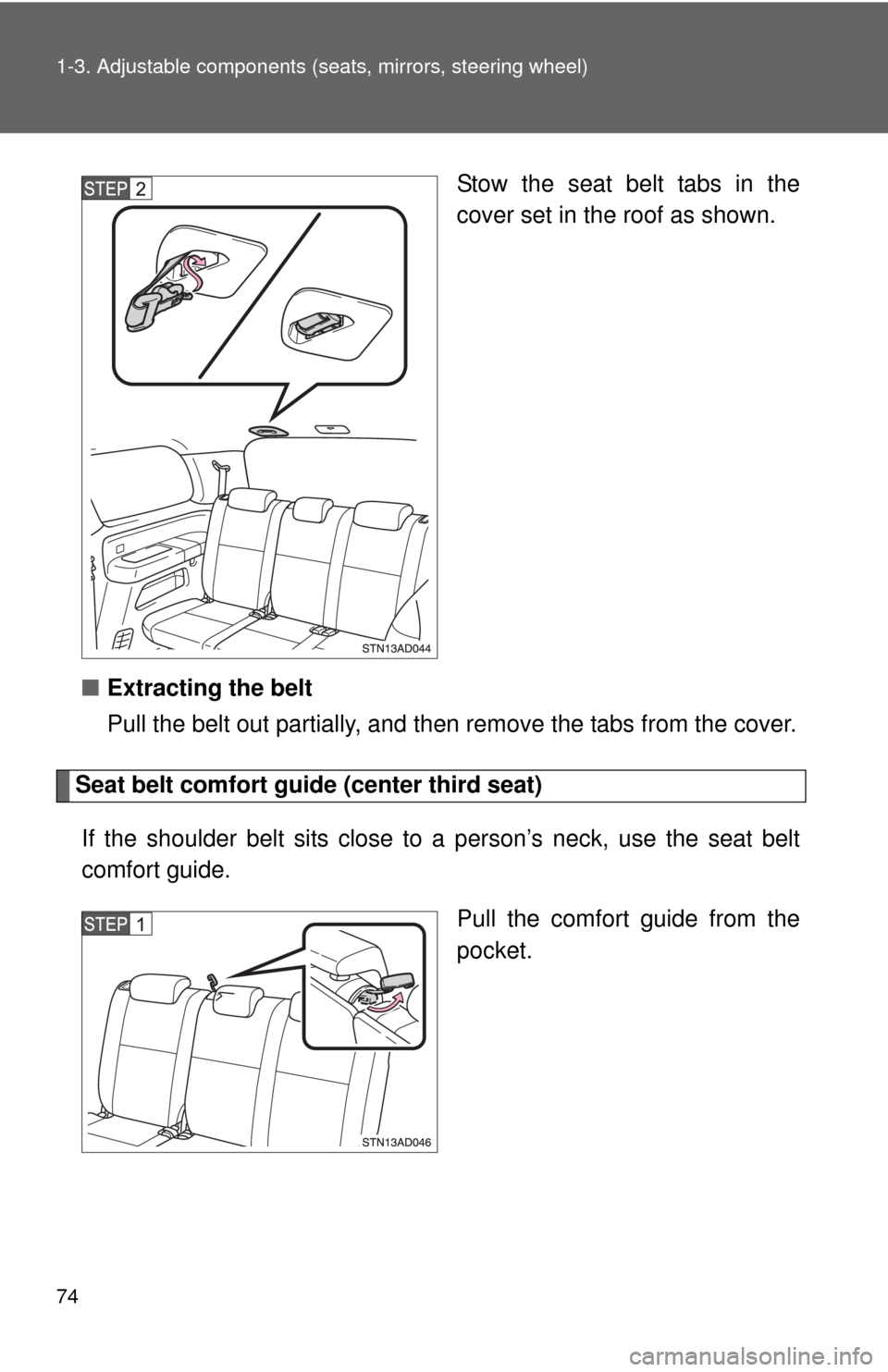
74 1-3. Adjustable components (seats, mirrors, steering wheel)
Stow the seat belt tabs in the
cover set in the roof as shown.
■ Extracting the belt
Pull the belt out partially, and then remove the tabs from the cover.
Seat belt comfort guide (center third seat)
If the shoulder belt sits close to a person’s neck, use the seat belt
comfort guide. Pull the comfort guide from the
pocket.